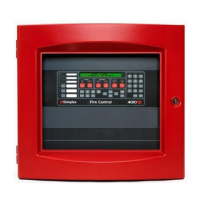7-3
WalkTest Overview
Overview WalkTest allows the function of the system’s initiating devices and signals to be tested by a single
person. Conducting a WalkTest requires you to perform the following steps.
• Step 1. Create WalkTest Groups. The 4010ES supports up to eight WalkTest groups. This
allows the building to be divided into small portions for the WalkTest, and allows the rest of the
building to be protected by the fire alarm panel. Each group has a list of monitor points
(initiating devices) and a list of the 4010ES signal circuits that activate when one of the group’s
control points activates.
Refer to Chapter 9 of the ES Panel Programmer’s Manual (574-849) for information on adding
monitor points (initiating devices) and signals/relays to a WalkTest group.
• Step 2. Enable WalkTest Options from Front Panel. These options include the
following. Refer to the “Setting WalkTest Options” later in this section for information on
setting these options.
- Which WalkTest Group is enabled.
- Whether the group’s signals turn on when a monitor point in the same group activates. Turn
this option on (along with the WalkTest logging option) to perform a silent WalkTest on the
system.
- Whether logging of WalkTest information is enabled or not. (Enable this option to perform a
silent WalkTest.)
Step 3. Manually Activate Initiating Devices in Each Group and Interpret Signals.
Individually activate each initiating device in the group, using a magnet or canned smoke. Make sure
to proceed in a logical manner (i.e., start with the lowest IDNet address and work toward the highest).
Each time you activate an initiating device, the system’s signals pulse a code that allows you to verify
exactly which initiating device triggered the signals. For hardwired monitor zones, the signal code
corresponds to the number of the zone. (For example, if the zone number is eight, the signals pulse
eight times to indicate zone eight.) For IDNet devices, the first set of pulses from the signals
corresponds to the channel. The signals then pause momentarily and the second set of pulses
corresponds to the number of the device on the channel. For example, if you activate an IDNet smoke
detector with an address of M1-25, the signals sound once to indicate channel one, pause for a short
duration, and then sound 2 times, pause, and then sound 5 times to indicate device 25.
In some cases, immediately after verifying the function of an initiating device, you may also want to
verify its ability to generate a trouble condition. To do this, cause a trouble on the device (i.e., remove
the sensor from a TrueAlarm device), and then listen to the signals. The signals sound steady for 4
seconds to indicate trouble conditions, then reset.
Important Notes Signals and initiating devices (with the exception of pull stations) automatically acknowledge and
automatically reset, allowing for one-man testing without the need for someone at the main control
panel to acknowledge and reset the system each time an initiating device and its associated signals
activate.
A silent Walk Test may be performed (no signals will sound) and logging of events may be selected.
Refer to “Setting WalkTest Options” below for additional information.
If an alarm condition is detected from a zone that is not in the present active Walk Test group, the
system will operate as a fire alarm panel and the active Walk Test groups are aborted.

